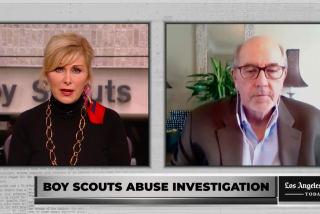TV breaking news was invented 70 years ago with tragic case of Kathy Fiscus
On April 8, 1949, Kathy Fiscus, her older sister and two cousins were scampering through an open field in San Marino, not far from the Fiscus house.
Kathy, 3, fell into an abandoned well on their way home. During the epic, but failed, effort to rescue her, the drama captured the nation’s attention, in large part due to television. It was a watershed moment for the medium.
Here is a look back from the pages of The Times.
An early TV movement
Television news was in its infancy then, but the drama riveted the nation. And how local stations covered the rescue effort became the blueprint for breaking news coverage that continues today.
As Times reporter Patt Morrison described it in 1999:
“Soon, other, unfamiliar equipment and other men showed up too: the lumbering trucks bearing cumbersome live TV apparatus and reporters from local stations KTTV and KTLA.
“Perhaps it was a good thing that so few people owned TV sets at the time, because the programming usually wasn’t much to brag about: boxing, wrestling, roller derby, dramas that were televised stage plays.
“Newscasts then were at most 15 minutes long, little more than radio with a face. And then came Kathy Fiscus’ ordeal, an event that helped to convert television from toy to tool. Of the 50-hour effort to rescue the child, 27 hours and 30 minutes were televised live by KTLA.
“At the time, there were perhaps 20,000 TV sets in Los Angeles, many of them in bars so patrons could watch sporting events. As word spread that this race to rescue could be seen live, neighbors scanned the roof lines for antennas to see who among them might have a TV. Strangers crowded into hardware stores where sets were sold. A young reporter named Cecil Smith, who would become The Times’ TV critic one day, was driving home at 2 a.m. when he saw a hundred people in front of a store window, watching the Fiscus rescue attempt on TV.
“Such fascination with live TV news would become a regular feature of American life as viewers followed riots, high-speed chases and even low-speed chases on the small screen. And in 1987, the successful 58-hour rescue of ‘Baby Jessica,’ an 18-month-old Texas girl who fell down a water well, again enthralled the nation; a TV movie of the event was titled ‘Everybody’s Baby.’
“In 1949, Kathy Fiscus was everybody’s baby. Television helped to make an instant family of the nation. Even as rescuers were digging, calls offering advice and help flooded police stations, newspaper offices, radio and TV stations.”
Inventing breaking news
Several TV reporters where involved in the coverage. But the one who became most prominent was KTLA’s Stan Chambers. In 1989, Chambers wrote a piece for The Times describing the scene:
“As efforts continued Saturday, one of television’s brilliant pioneers, KTLA General Manager Klaus Landsberg, made the decision to provide live coverage. All programming and commercials were canceled, and Bill Welch and I began our open-ended, uninterrupted reports from the scene that afternoon.
“KTLA’s marathon, 27½-hour coverage of the rescue attempt was one of the turning points in television history.
“Up until then, television was a flickering new novelty and not taken seriously by many people. This telecast changed that view forever. People were irresistibly drawn to the tragic reality that was taking place on the screen of their living-room set. It was a television experience they would remember a lifetime.
“I still have several people tell me each week how vividly they remember the Kathy Fiscus telecast.
“It seemed as if all of Los Angeles stopped to watch the drama unfold. Neighbors who had rarely spoken to each other became close friends as they sat in front of black-and-white television sets. They sipped coffee and munched on sandwiches throughout the night. A hard-boiled city poured out its tears and silent prayers as frantic men worked in a dark tunnel trying to rescue a little girl.
“Then came the devastating moment Sunday night when a doctor used a public address system to announce that Kathy was dead. Tired, dirty, beaten men with 40 and 50 hours of constant work behind them wept openly with bitter tears. Rescuers stood silently, heads bowed, unwilling to accept the news. The crowd of thousands was stunned. Viewers at home felt the pang of sorrow. There was no way to express the loss.
“The only solace was the fact that she probably died shortly after she fell into the well Friday night and did not suffer long.
“The outpouring of mail after the Kathy Fiscus telecast was overwhelming and emotional. It also bore witness to the powerful, yet intimate role that television would come to play in its viewers’ lives.
“‘Until last night, the television set was no more a threat to serenity than any other bit of furniture in the living room. Now you have utterly destroyed this safety forever,’ wrote a man named Stewart Stern.”
Narrating history — live
In 1987, Landsberg’s former wife, Evelyn DeWolfe, wrote about how the coverage came together:
“The events preceding the Fiscus telecast are somewhat unclear in my mind. What I can remember is a hurried dinner that first evening with constant phone interruptions after KTLA founder Klaus Landsberg, to whom I was married at the time, was informed of the accident.
“The news of Kathy’s plight had already spread and Klaus was keeping close tabs on the rescue progress. Within an hour or two, he had made his decision to line up his remote crew and head for the rescue site to set up a complex hook-up system. Nothing like this had ever been done before.”
“When KTLA’s two mobile units arrived, firemen had already been on the scene for several hours, lowering air hoses into the shaft. Newsmen and newsreel cameras were everywhere. Four cranes were brought in, and a well digger and four bulldozers were put into action. The area was lit by 50 searchlights powered by portable generators.
“The files of Hollywood’s Central Casting were being searched for midgets who might be used to descend the pipe to reach the girl. A thin man from the Clyde Beatty Circus and Philip Morris’ call boy Johnny volunteered, but neither was small enough to enter the shaft.
“During the long ordeal, I was asked to bring a fresh change of clothes to Klaus, who never left the site. When he finally returned home two days later, bearded and totally exhausted, I remember him saying, ‘This is tragic, but this is also television history.’”
Times staff writer Shelby Grad contributed to this report.
More to Read
Sign up for Essential California
The most important California stories and recommendations in your inbox every morning.
You may occasionally receive promotional content from the Los Angeles Times.










